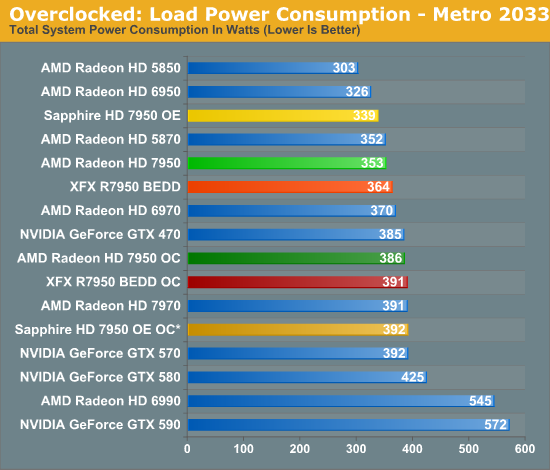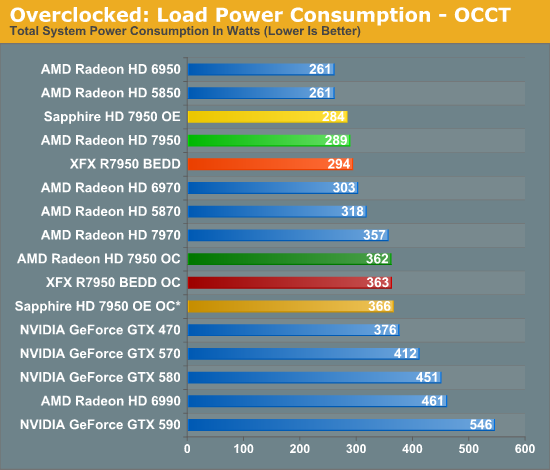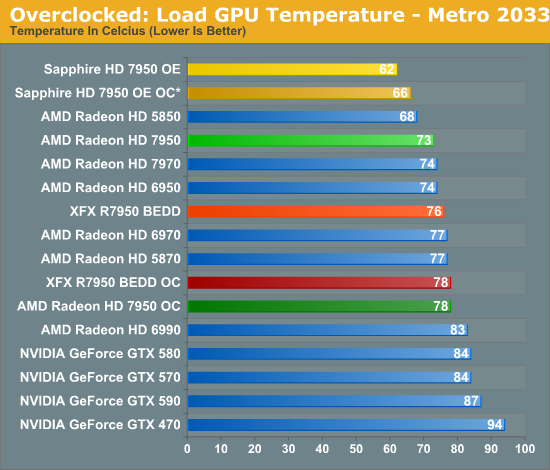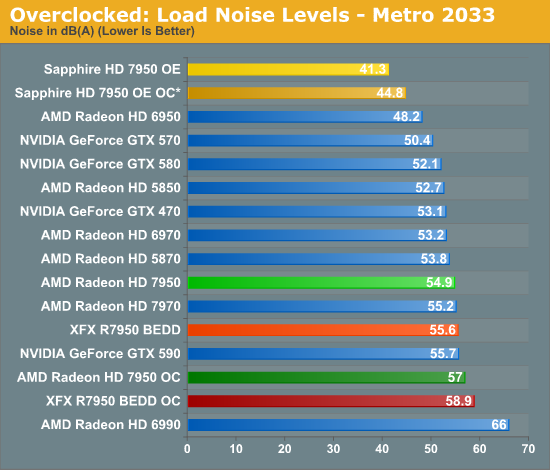AMD Radeon HD 7950 Review Feat. Sapphire & XFX: Sewing Up The High-End Market
by Ryan Smith on January 31, 2012 9:02 AM ESTOverclocking: Power, Temp, & Noise
In their marketing materials AMD is heavily pushing overclocking, and they have good reason to. With the 7970 we’ve established that Tahiti has quite a bit of overclocking headroom, and as the 7950 is clocked lower by default this opens up that headroom even further. Realistically AMD’s binning process means that the best clocking Tahiti GPUs are going to be allocated to the 7970 unless they have failed shaders, but even with that there’s quite a bit of potential on paper.
As with overclocking the 7970, our goal overclocking the 7950 is to see how much you can get for free; that is without any voltage adjustments. AMD’s reference PCBs are not particularly overbuilt for overclocking—cards like that will come later—so sticking to the reference voltage is the safest option, not to mention the easiest. With the 7970 we were able to get 200MHz (22%) overclocks without any voltage adjustment, and we’re hoping for the same out of the 7950.
With that said, we quickly ran into a wall on one card: the Sapphire 7950. Sapphire’s low VID of 0.993v may be great for temperature and noise at stock, but it’s not doing overclocking any favors. We only hit 950MHz at that voltage. As the Sapphire was the odd man out—every other card was at 1.093v—we did end up overvolting the Sapphire to 1.093v to see what it was capable of when put on similar footing as the rest of our cards.
After bringing up the voltage of our Sapphire card, all of our 7950s ended up overclocking to very similar levels. Our Sapphire and AMD cards topped out at 1025MHz core, a 225MHz (28%) overclock over a stock 7950 and a 125MHz (14%) overclock over the Sapphire’s factory overclock, while our XFX card reached 1050MHz, a 150MHz (17%) overclock beyond XFX’s factory overclock. Meanwhile the memory clocks on all of our cards topped out at 5.8GHz, beyond which we’d start seeing performance regressions from error correction on the memory bus.
| Radeon HD 7950 Overclocking | |||||
| AMD Radeon HD 7950 | Sapphire HD 7950 Overclock Edition | XFX R7950 BEDD | |||
| Shipping Core Clock | 800MHz | 900MHz | 900MHz | ||
| Shipping Memory Clock | 5GHz | 5GHz | 5.5GHz | ||
| Shipping Voltage | 1.093v | 0.993v | 1.093v | ||
| Overclock Core Clock | 1025MHz | 1025MHz | 1050MHz | ||
| Overclock Memory Clock | 5.8GHz | 5.8GHz | 5.8GHz | ||
| Overclock Voltage | 1.093v | 1.093v | 1.093v | ||
As you can imagine, with such similar overclocks, gaming performance on all 4 cards ended up being very similar. So we’ll get to gaming performance in a minute, while we’ll start with power, temperature, & noise.


Even though we’re not increasing the voltage on our AMD and XFX cards, merely overclocking them and raising the PowerTune limit to avoid throttling does drive the power consumption up. As is typical with heavily overclocked cards, overclocking quickly drives up power consumption and the 7950s are no exception. After overclocking power consumption is almost identical to the stock 7970, so while you can get 7970 performance you still need to pay the price with 7970 power consumption. Meanwhile it’s interesting to note that even with the extra 0.1v we’ve given the Sapphire card its final power consumption is only ever so slightly higher than the other 7950s, proving that voltage is the great equalizer in this case.


With the increase in power comes an increase in temperatures. The Sapphire card still does very well here staying in the low 70s even under OCCT, while the reference and XFX cards hit the high 70s under Metro and mid 80s under OCCT. As we’ve yet to really ascertain what the thermal limits are for Tahiti, it’s not clear whether there’s too much thermal headroom left for the GPU, particularly under OCCT.


Last but not least we have load noise. The Sapphire card is once more a stellar performer, and we still can’t get it above 50dB even with OCCT. Unfortunately the XFX 7950 BEDD has its biggest fallout yet—it may be able to overclock well, but at 64dB under OCCT the performance isn’t going to be worth the immense amount of noise it creates to move enough air to keep the GPU cool.










259 Comments
View All Comments
Galidou - Tuesday, January 31, 2012 - link
Well then everything you said is nothing new, and is quite useless, that's what I meant. What's the point mentioning that it always has been like that and say it like if it's totally shocking like if it's new.''In other words, if you wanted this level of performance, you could've gotten it a year ago with the GTX 580 for almost the same price....over a year ago....
And that's why AMD's pricing of these parts fails.''
Than marketting the way is done nowadays is a big FAIL but everyone knows it, ALWAYS has been like that... Car manufacturer makes new cars every year and sometimes it's worse than last year's, and higher priced....
Ever heard of programmed obsolescence??
chizow - Tuesday, January 31, 2012 - link
But this ISN'T how it usually goes, its unprecedented which is why many observers are pointing out the inconsistency. Look at history and even your own examples to show how this is out of the norm.I will leave you with one final question and you try to answer it with a straight face.
If Nvidia launched their new "next-gen" architecture on a new process node like 15nm in 12-13 months and it was only 15-25% faster than the 7970 but cost 10% more, would you be happy with it and consider it some great victory???
I don't know, I mean every way you possibly look at this, it just isn't right.
xeridea - Tuesday, January 31, 2012 - link
I would poo my pants because Nvidia actually did a process shrink ahead of schedule. BY THE WAY 14nm is 2 shrinks from now, and will be about 5 years down the road.Following your conversation, you clearly don't know the reason behind pricing scheme. There is 0 competition with the 7900 series right now, and it is still better price/performace at its high price. Price will go down in time, but cards are always more expensive on release.... welcome to the real world.
You could get the 580 last year for $50 more than the 7950, while using 30-80W more power (idle-game), running 10-25C hotter under load, making more noise, and slightly less performance (even with fairly new drivers for 7950).
chizow - Tuesday, January 31, 2012 - link
Uh, no I understand perfectly why they're pricing it this way.They're trying to make money and capitalize on the brief period of time they can actually charge a premium for holding the performance crown.
But that's not going to stop keen observers like myself for calling them on it, especially when they're pricing last-gen performance at next-gen prices. They might swindle a few of their unwitting fans this time around but this will only hurt them in the long run. And by long, I mean as soon as Kepler launches.
mdlam - Tuesday, January 31, 2012 - link
Too bad your "keen" observations prevented you from noticing that Nvidia is also pricing their 14 month old technology at premium prices? Wait maybe it is because you are a Nvidia fanboy! I won't ever get swindled by AMD, I will only be swindled by Nvidia, says the retard.SlyNine - Tuesday, January 31, 2012 - link
Then go back and look at other launches. Get the facts and stop using Adhominem attacks and showing your ignorance.chizow - Tuesday, January 31, 2012 - link
No, Nvidia priced their last-gen performance based on last-gen premiums, you would expect the next-gen to shift these parts to obsolescence but obviously AMD doesn't feel their users possess the acumen to understand this paradigm.As for retards being swindled by Nvidia, lmao, the difference is, they would've been reveling in their ignorant bliss with this level of performance, 14 months ago. For the same price.
Its truly amazing though, because you're falling into the exact trap AMD expects you to fall for with the pricing of this card. Honestly how can anyone defend the price and performance metric of this card 14 months later?
mdlam - Tuesday, January 31, 2012 - link
AMD doesn't give a shit whether you fall for anything, neither does Nvidia. If enough people buy their cards at X price to support their billion dollar companies, then the price stays. If not, the price goes down. If more people than not refuse to buy the product, then price goes....up.... Whether its this metric or that metric or not fair or super clever AMD trap its all bullshit people make up who hold little educational knowledge in economics or business.mdlam - Tuesday, January 31, 2012 - link
People like you btw.chizow - Wednesday, February 1, 2012 - link
Sounds like someone missed their nap.AMD should care actually, because the only people who would even entertain buying one of these cards are their biggest fans, the ones who are going to feel the burn the worst when the floor drops on the pricing of these products.
Again, there is precedent for this, AMD did it to Nvidia in 2008 and Nvidia was cutting rebate checks. Do you think AMD is willing to do the same?